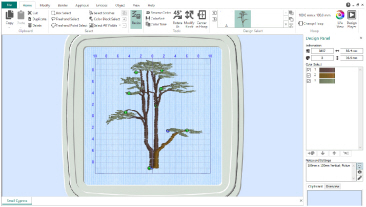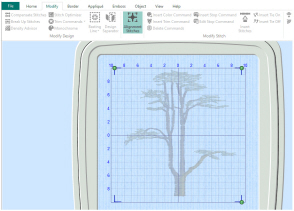Use Alignment Stitches ![]() to mark the first or last subdesign as an alignment stitch subdesign.
to mark the first or last subdesign as an alignment stitch subdesign.
Use Alignment Stitches to align your embroidery with the background fabric, or with another embroidery.

Select the alignment stitch section on the work area using the select tools in the Home tab, then click Alignment Stitches ![]() in the Modify tab to flag it as a set of alignment stitches.
in the Modify tab to flag it as a set of alignment stitches.
To mark a set of alignment stitches as a normal subdesign, select the section in the Home tab, and then deselect Alignment Stitches ![]() in the Modify tab.
in the Modify tab.
Either the first or last subdesign in a design can be marked as Alignment Stitches. In the Home tab an Alignment Stitch subdesign is shown by the letter ‘A’ in the Design Select gallery, rather than the number used for standard subdesigns.
Most editing functions are not available for Alignment Stitch subdesigns. To edit the subdesign, change it to a normal subdesign, edit it, then change it back again after editing.
-
When a .vp4 design with alignment stitches is Opened
 , the alignment stitches are retained.
, the alignment stitches are retained. -
When a .vp4 design with alignment stitches is Inserted
 into a project, the alignment stitches are discarded.
into a project, the alignment stitches are discarded.
To change the alignment stitches in a .vp3 format embroidery into an alignment stitch subdesign, use Design Separator ![]() to create two different subdesigns; one for the embroidery, and one for the alignment stitches. Then in the Design Select area on the Home tab, move the alignment stitches to the front (or back) of the design. With the alignment stitches selected, click Alignment Stitches
to create two different subdesigns; one for the embroidery, and one for the alignment stitches. Then in the Design Select area on the Home tab, move the alignment stitches to the front (or back) of the design. With the alignment stitches selected, click Alignment Stitches ![]() in the Modify tab to change them into an ’A’ alignment stitch subdesign.
in the Modify tab to change them into an ’A’ alignment stitch subdesign.
Shortcuts
-
Modify Tab:

-
Keys: Alt, M, A
Using Alignment Stitch Sections
-
Click Change Hoop

. From the Universal Hoop Group, set the Hoop Size to 100mm x 100mm - Universal Square Hoop 1. Click OK.
-
Ensure that the Home tab is selected.
-
Click File, Open

to open an existing design in a new window.
-
In the folder *Documents\mySewnet\Samples\Stitch Editor\Stitch load the 'Small Cypress' embroidery.
-
In the Design Select area, click design ’A’ - the alignment stitches. Most of the editing functions become unavailable (grayed out).
-
Click the Modify tab. Alignment Stitches

is enabled, but all other functions are disabled.
-
Click Alignment Stitches

. The editing functions are now available.
-
Click the Home tab. In the Design Select area the alignment stitch section is now subdesign 1, and the tree has been renumbered to 2.
-
Close the window without saving your changes.
-
Click File, New

to open a new window.
-
In the Quick Access toolbar, click Insert

.
-
In the folder Documents\mySewnet\Samples\Stitch Editor\Stitch load the 'Small Cypress' embroidery.
-
Look at the Design Select area. This time there is no Alignment Stitch subdesign.
The embroidery is opened with the second subdesign selected, the tree, as the first subdesign is alignment stitches.
You cannot edit the stitches in an alignment stitch subdesign.

When you Open
an existing embroidery the alignment stitches are retained, as they are part of a complete design. However, when you Insert
a design into an existing project, any alignment stitches are not needed, so they are not retained.
Convert the Alignment Stitches in a .VP3 Embroidery
To change the alignment stitches in a .vp3 or other format embroidery into an alignment stitch subdesign, do as follows:
-
Load the embroidery to be converted.
-
Click the Modify tab.
-

to create two different subdesigns; one for the embroidery, and one for the alignment stitches.
-
Click the Home tab.
-
In the Design Select area of the ribbon bar, move the alignment stitches to the front (or back) of the design.
-
Click the Modify tab.
-
With the alignment stitches selected, click Alignment Stitches

to change them into an ’A’ alignment stitch subdesign.
Return to the Home tab to check that the alignment stitches are now an Alignment Stitch subdesign.